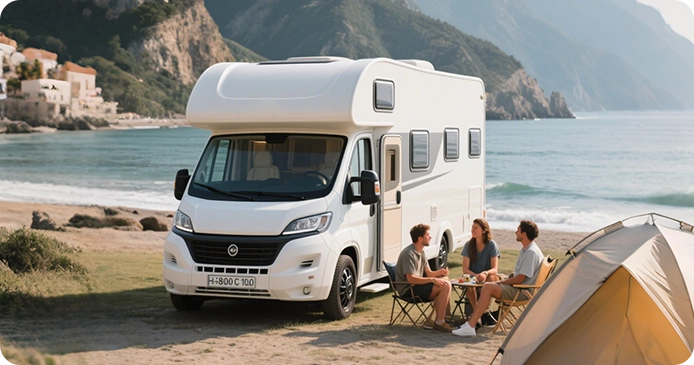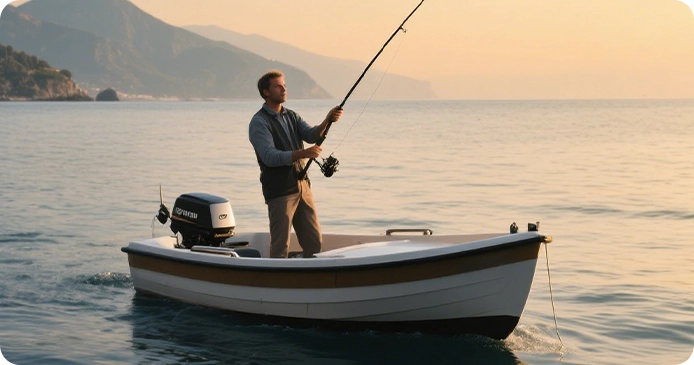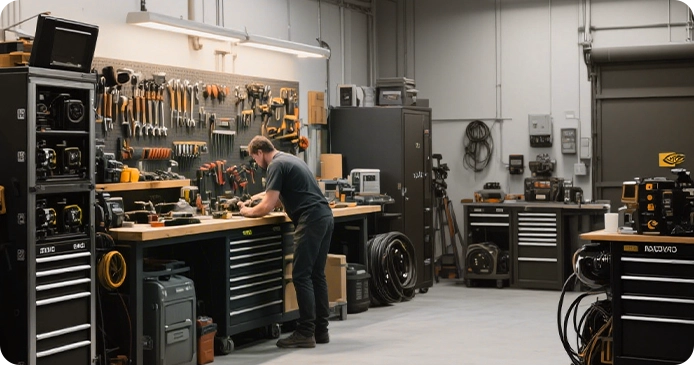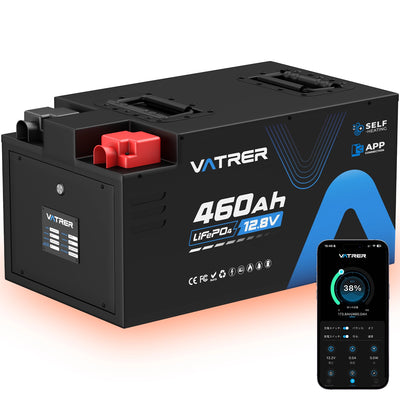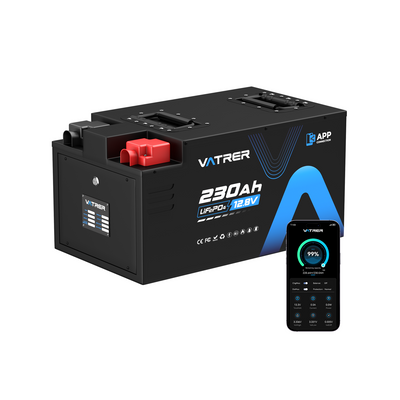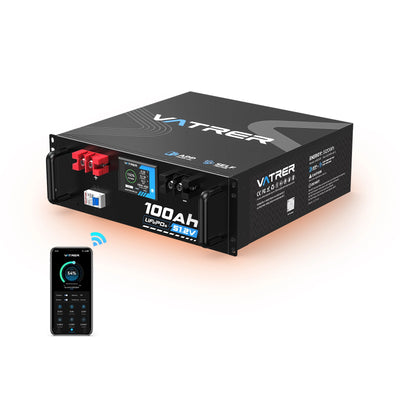電池の直列接続と並列接続:理科の授業の思い出を残さずにプロのように配線する
Reading time Less than 1 minute
電気技師のお気に入りの甥っ子のように、バッテリーの配線方法を学びましょう。電圧を重ねる(直列)、動作時間を延ばす(並列)、あるいはマッドサイエンティスト的な(直並列)接続を、方程式を使わずに豊富な実例を使って解説します。
たくさんの電池が余っていて、DIY プロジェクトを大失敗にせずにそれらを配線する方法を考えているところです。
直列か並列か?
高校の理科の先生が聞いてそうな質問ですよね?ご安心ください。まるでフェンス越しに隣人と話しているように、分かりやすく解説します。最後まで読めば、 RV、ボート、ゴルフカートをプロのようにパワーアップさせる方法を確実に理解できるはずです。
バッテリーの正しい配線が重要な理由
まずは簡単なところから始めましょう。バッテリーは車のガソリンタンクのようなものです。燃料ではなく、電気を蓄えるという点が異なります。
接続方法によって、タンク容量(稼働時間の増加)の増大やエンジン速度(電圧の上昇)の上昇が決まります。接続を間違えると、バッテリーバンクが空になったり、最悪の場合、溶けてしまう可能性があります。これは良くありません。
要点はこうです。直列配線はパンケーキのように電圧を積み重ねます。並列配線はBOGOのように動作時間を2倍にします。ただし、これらを間違って組み合わせると、煙がなぜ悪臭を放つのかが分かります。さあ、詳しく見ていきましょう。
直列配線:より強力なパワーが必要な場合
36ボルトの電圧が必要なトローリングモーターに電力を供給したいのに、12Vのバッテリーしか持っていないと想像してみてください。問題ありません。3つのバッテリーを直列に(プラスとマイナス、マイナスとプラス)接続すれば、あっという間に36Vになります。まるで電車の車両を連結するようなものです。各バッテリーの電圧が合計に加算されますが、駆動時間(アンペア時間)は変わりません。
例: 12V、100Ahのバッテリーを3個直列に接続すると、36V、100Ahになります。ゴルフカートや高級トローリングモーターなど、高い電圧を必要とする機器に最適です。
V = 12V * 3 = 36V
利点:直列接続により、小型で安価なバッテリーを使用して高電圧の目標を達成できます。さらに、電流(アンペア)が低く抑えられるため、細いワイヤーでも使用できます。まるで消防ホースから勢いよく飲み物を飲むのではなく、ストローで飲み物を飲むような感覚です。
デメリット:バッテリーが1つ切れると、チェーン全体が暗くなります。まるで90年代のクリスマスイルミネーションのようです。また、充電も難しい場合があります。直列接続したバッテリーは必ずしも均等に充電されるとは限らないので、バッテリーマネジメントシステム(BMS)による審判が必要になります。プロのヒント:同じバッテリーを使用してください。ウォルマートの特価品とVatrerのプレミアムリチウムバッテリーを混ぜるのは、ビーチサンダルとタキシードを合わせるようなものです。うまくいきません。
並列配線:パーティーを盛り上げたいとき
さて、RVの冷蔵庫が午前2時に頻繁に切れてしまい、夜食ゲームが台無しになってしまうとしましょう。バッテリーを並列接続すれば、この問題は解決します。プラスとマイナスをすべて繋げば、電圧はそのままで稼働時間が2倍になります。トラックの荷台にガソリン缶を追加するようなものです。走行距離は伸びますが、速度は変わりません。
例: 12V、100Ahのバッテリーを2つ並列接続すると、12V、200Ahになります。RVのライトは長持ちし、携帯電話の充電は長持ちし、冷たいビールは冷たく保たれます。優先順位は重要です。
100Ah * 2 = 200Ah
メリット:並列接続は故障しにくい。1つのバッテリーが切れても、他のバッテリーが(電力は少なくなりますが)点灯し続ける。充電も簡単で、ほとんどの12V充電器は特別な機器を使わずに並列接続に対応できる。
デメリット:高電流に耐えられるよう、太い電線が必要です。ここでケチると、電線がTikTokのトレンド動画よりも熱くなる可能性があります。また、異なる種類のバッテリーを並列接続すると、トラブルの原因となることがあります。1つのバッテリーがすべての電力を独占したり、他のバッテリーを消耗させたりする可能性があります。ブランド、製造年、容量を統一しましょう。ボーイズバンドのように、ハーモニーが重要です。
直並列:究極のパワーオタク向け
電圧と動作時間の両方が必要な場合、直並列配線が役立ちます。このハイブリッド構成は、まるでバッテリーのボルトロンを組み立てるようなものです。まずバッテリーを直列パックにまとめ、次にそれらを並列に配線します。
実例: 12Vバッテリー4個 → 2組を直列接続(それぞれ24V) → それらの組を並列接続。結果的に、アンペアアワーが2倍になる24Vシステムになります。大型RV、太陽光発電システム、週末を通してクルージングする必要があるボートなどに最適です。
細則:
これは初心者向けではありません。適切なバッテリー、頑丈な配線、そしてすべてを一列に並べるためのBMSが必要です。しかし、うまくいけば、アイアンマンスーツを動かすトニー・スタークのような気分になるでしょう。
配線方法(小屋を燃やさずに)
シリーズ向け
- バッテリーをドミノのように並べます。
- バッテリー 1 のプラスをバッテリー 2 のマイナスに接続します。これを繰り返します。
- マルチメーターを使って合計電圧をチェックしてください。電圧が合わない場合は、接続が緩んでいるか、電池が切れてしまっている可能性があります。
並列の場合
- バッテリーを並べて駐車します。
- すべてのプラスを太いケーブルで接続し、次にすべてのマイナスを接続します。
- デバイスをパックの反対側に接続してください。これにより負荷が均衡し、電子が無駄に消費されるのを防ぎます。
必要なギア
- 強力なケーブル(100円ショップのジャンク品ではありません)。
- 圧着工具、熱収縮チューブ、そして火花に対する健全な恐怖。
充電:大切なバッテリーをダメにしないために
直列充電:バッテリーパックの合計電圧に合った充電器を使用してください。36V直列接続の場合は、36V充電器が必要です。充電が均一でない場合は、バッテリーの不一致、またはBMSの故障が考えられます。
並列充電:簡単モード。標準的な12V充電器でも使えますが、古いバッテリーには注意してください。新しいバッテリーが充電している間、古いバッテリーの性能が落ちてしまう可能性があります。
黄金律:バッテリーの種類を混ぜて使用しないでください。リチウム、鉛蓄電池、AGMバッテリーは犬猫のように仲が悪く、仲良く遊べません。同じ化学組成のバッテリーを選べば、メルトダウンを防ぐことができます。
よくある質問(まだ疑問に思っていることは承知しています)
古い電池と新しい電池を混ぜてもいいですか?
技術的には可能ですが、現実的には無理です。古いバッテリーは、出かけるたびに財布を「忘れる」友達のように、新しいバッテリーの寿命を縮めてしまいます。
どちらの設定の方が長持ちしますか?
並列接続 = 動作時間が長くなります。直列接続 = 電圧が高くなります。バッテリーの寿命は?それはあなたの扱い方次第です。清潔に保ち、充電し、高温にさらさないようにしてください。
バッテリーはいくつ接続できますか?
配偶者が散らかり具合を文句を言うまでは。冗談です。厳密な制限はありませんが、現実的な範囲にしてください。バッテリーの数が増えると、重量もコストも複雑さも増します。
まとめ
- シリーズ= 電圧ブースト (高出力ギアに適しています)。
- 並列= 実行時間の短縮 (マラソンセッションに適しています)。
- 直列-並列= 両方の長所を兼ね備えたもの (電力を大量に消費するオタク向け)。
もしこれが難しそうなら、BMS内蔵のリチウム電池を買ってみてください。バッテリー界のテスラみたいなものです。スマートでスタイリッシュ、そして故障しにくい。
さあ、電力需要を克服しましょう。そして覚えておいてください:焦げ臭いにおいがしたら、まずプラグを抜いて、それからパニックに陥ってください。
シェア


























